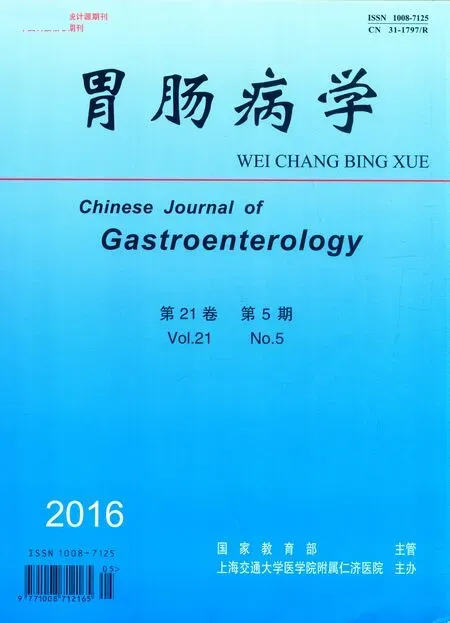内皮素-1在炎症性肠病发病中作用的研究进展*
安博然 祝 斌
广东医科大学1(524023) 中国人民解放军第422医院消化内科2
内皮素-1在炎症性肠病发病中作用的研究进展*
安博然1祝斌2#
广东医科大学1(524023)中国人民解放军第422医院消化内科2
摘要炎症性肠病(IBD)是一种病因尚未完全明确的慢性非特异性肠道炎性疾病,包括克罗恩病(CD)和溃疡性结肠炎(UC)。内皮素-1(ET-1)是一种由21个氨基酸残基组成的活性多肽,具有较强的收缩力,可通过活化血管平滑肌的电位依赖性钙离子通道发挥收缩血管作用。研究显示ET-1在IBD的发生、发展中发挥重要作用。本文就ET-1在IBD发病中作用的研究进展作一综述。
关键词Crohn病;结肠炎,溃疡性;内皮素-1;受体,内皮素A;受体, 内皮素B;拮抗剂
Receptor, Endothelin B;Antagon
炎症性肠病(IBD)是一种病因尚未完全明确的慢性非特异性肠道炎性疾病,包括克罗恩病(CD)和溃疡性结肠炎(UC)。目前认为IBD的发生与遗传和环境因素相关,是遗传易感者在环境因素作用下引起的免疫反应,从而导致肠道黏膜损伤[1]。研究[2]显示内皮素-1(endothelin-1,ET-1)在IBD的发生、发展中发挥重要作用。本文就ET-1在IBD发病中作用的研究进展作一综述。
一、ET-1与IBD
1. ET-1:ET-1是1989年由日本学者Yanagisawa等[3]从猪主动脉内皮细胞中分离纯化出的一种由21个氨基酸残基组成的活性多肽,具有较强的收缩力,可通过活化血管平滑肌的电位依赖性钙离子通道发挥收缩血管作用。ET-1另有两个同分异构体家族即ET-2和ET-3,三者的差异在于个别氨基酸残基不同,其中对心血管起主要作用的是ET-1。ET家族成员最初均以约200个氨基酸残基构成的前内皮素原形式存在,200个氨基酸残基中的40个具有生物活性的氨基酸残基组成大内皮素,后者在内皮素转换酶(endothelin-coverting enzyme, ECCE)的修饰下转化为具有生物活性的多肽ET[4-5]。ET主要存在于血管内皮,亦少量见于多种组织和细胞中,是目前已知最强的缩血管物质之一,可刺激血管平滑肌和成纤维细胞增殖、气管和肠道平滑肌重塑、增强心脏收缩力、提高心率、促进心房钠尿肽分泌,亦与氧化应激有关[6-8]。有研究指出,ET-1与高血压、心肌梗死、心源性休克、动脉硬化、雷诺病、蛛网膜下腔出血、尿毒症、IBD等疾病有关[9]。
2. ET-1与IBD:有关ET-1在IBD中的作用存在争议。1992年Murch等[10]对 25例IBD患者(16例CD、9例UC)病变肠道组织与13名健康人肠道组织的ET-1水平进行对比,发现CD和UC患者肠道组织ET-1水平显著高于健康人。在结肠固有层中,UC患者的ET-1水平显著高于CD患者,但在黏膜下层却呈相反结果。该研究认为在IBD发病过程中ET-1可通过收缩血管引起小肠局部缺血,从而导致血管炎症,参与IBD的发生。然而,同年Rachmilewitz等[11]的研究采用了与上述研究相同的样本量和检测方法,却未能得出相同结论,该研究认为ET-1与IBD的关系仍需进一步探讨。Letizia等[12]对29例CD患者、13例UC患者以及26名健康人血浆ET-1水平进行检测,发现CD和UC患者血浆ET-1水平均显著高于健康人,尤以CD患者升高更为明显。该研究发现,血浆ET-1水平不受年龄、性别、疾病活动性、初发或再发、疾病累及范围以及治疗等因素影响。王建云等[13]对UC患者肺损害程度与ET-1水平的关系进行研究,发现UC患者血清ET-1水平越高,肺损害越严重。Nakamura等[14]对UC患者血浆ET-1水平进行检测,结果显示UC患者血浆ET-1水平显著高于正常人。然而,Yu等[15]的研究结果发现,ET-1在IBD患者肠道组织中表达下降,且ET-1与转录因子NKX2-3表达呈负相关,提示NKX2-3通过负性调节ET-1的表达参与IBD的发生。McCartney等[16]将IBD患者与TNBS诱导的结肠炎大鼠模型的结肠组织ET-1浓度进行比较,结果显示IBD患者结肠组织ET-1/2水平下降,但TNBS诱导的结肠炎大鼠结肠组织ET-1/2水平显著升高。IBD患者结肠组织主要表达ET-2,而TNBS诱导的结肠炎大鼠模型结肠组织主要表达ET-1,与TNBS诱导的结肠炎大鼠模型不同,人类IBD与ET表达无明显相关性。上述研究结果的差异可能与实验方法、样本量、研究对象不同有关。
目前已知7种基因 EDN1、EDN2、EDN3、ECE1、ECE2、EDNRA以及EDNRB与ET的活性相关[5,17-19]。ET相关基因通路可分为两类,一类为ET基因和ECCE基因,另一类为ET受体(ETR)基因。Cheluvappa等[20]运用基因集富集分析(GSEA)表明,ETR表达与ET活性呈负相关,ETR表达可能受ET负反馈调节。
二、ETR及其拮抗剂与IBD
1. ETR:目前已明确两种ETR,即ETA和ETB,第3种受体发现于两栖类非洲爪蟾,对ET-3具有高度选择性,被命名为ETC[21]。目前对ETC的作用存在争议,但已证实ET主要通过ETA和ETB发挥作用。ETA主要存在于肌细胞中,ETB主要存在于内皮细胞中。ETA对ET-1和ET-2具有高选择性和亲和力,对ET-1的亲和力大于ET-2,对ET-3的亲和力较弱。ETB对ET-1、ET-2和ET-3的亲和力无明显差异,是一种非选择性受体。ETA包含427个氨基酸,主要介导血管收缩,对ET-1产生放大效应。ETB包含442个氨基酸,与ET-1清除、内皮细胞存活、前列腺素合成、抑制ECCE-1和NO合成酶有关[8,22-23]。Rapoport等[24]认为ETA与ETB间存在交互作用,选择性阻断ETA或ETB可阻止ET-1应答,但此机制可因未被阻断的受体产生补偿作用,ET-1仍能与未被阻断的受体结合从而发挥作用。
2. ETR拮抗剂与IBD:1993年ETR拮抗剂波生坦(Bosentan)问世,其可选择性作用于肺血管,使血管舒张,降低肺动脉压力;逆转血管壁增生、肥厚;抑制ET-1介导的胶原形成,抗纤维化;促进NO生成,恢复血管内皮舒张功能,主要用于肺动脉高压患者[25]。2008年Kirkil等[26]将波生坦应用于碘乙酰胺诱导的结肠炎大鼠模型,发现波生坦治疗组大鼠肠黏膜损伤指数和腹膜炎评分明显降低,推测波生坦通过阻断ETR,从而抑制碘乙酰胺诱导的肠道炎症,促进受损肠黏膜愈合。
在生理学和病理生理学过程中,ET-1需与血管因子(如NO)联合作用发挥效应,两者可直接或间接相互影响。ET-1可使内皮型NO合成酶活性降低,从而影响NO合成,并可促进NO降解;NO可抑制ET-1功能[6,27]。IBD患者出现微循环障碍多与NO介导的血管舒张失调有关[28],血管内皮系统在正常黏膜免疫和IBD特异性炎症过程中均发挥重要作用[29]。抑制ET-1介导的血管收缩,需先阻断ETA和ETB。与ETB相比,波生坦对ETA的亲和性更高,且和其他一些ETR拮抗剂对控制炎症反复迁延具有一定作用。LU-135252是一种选择性ETR拮抗剂,可选择性抑ET-1活性,影响微循环。Kruschewski等[30]将LU-135252作用于TNBS诱导的结肠炎大鼠模型,结果表明LU-135252可明显改善肠道微循环以及肠道炎症程度,证实微循环障碍可能与IBD的发病有关。
三、结语
IBD的发病机制是医学界的研究热点。目前对ET及其受体的研究发现,ET参与了多种疾病的发生、发展。在IBD的发病和病程进展中,免疫细胞(B细胞和T细胞)和非免疫细胞(内皮细胞)均在其中发挥重要作用。内皮细胞可通过释放ET-1,引发微循环障碍,参与IBD炎症发生。有研究者将ETR拮抗剂应用于IBD动物模型,证实其可缓解IBD肠道炎症,提示对ET作用机制的研究有助于明确IBD的发生机制,ETR拮抗剂有望作为治疗IBD的新手段。然而,相关研究仍处于起始阶段,结论有待进一步证实。
参考文献
1 Nunes T, Fiorino G, Danese S, et al. Familial aggregation in inflammatory bowel disease: is it genes or environment?[J]. World J Gastroenterol, 2011, 17 (22): 2715-2722.
2 Claudino RF, Marcon R, Bento AF, et al. Endothelins implicated in referred mechanical hyperalgesia associated with colitis induced by TNBS in mice[J]. Can J Physiol Pharmacol, 2010, 88 (6): 661-667.
3 Yanagisawa M, Massaki T. Molecular biology and biochemistry of the endothelins[J]. Trends Pharmacol Sci, 1989, 10 (9): 374-378.
4 Yanagisawa M, Kurihara H, Kimura S, et al. A novel peptide vasoconstrictor, endothelin, is produced by vascular endothelium and modulates smooth muscle Ca2+ channels[J]. J Hypertens Suppl, 1988, 6 (4): S188-S191.
5 Inoue A, Yanagisawa M, Kimura S, et al. The human endothelin family: three structurally and pharmacologically distinct isopeptides predicted by three separate genes[J]. Proc Natl Acad Sci U S A, 1989, 86 (8): 2863-2867.
6 Bourque SL, Davidge ST, Adams MA. The interaction between endothelin-1 and nitric oxide in the vasculature: new perspectives[J]. Am J Physiol Regul Integr Comp Physiol, 2011, 300 (6): R1288-R1295.
7 Khimji AK, Rockey DC. Endothelin -- biology and disease[J]. Cell Signal, 2010, 22 (11): 1615-1625.
8 Westby CM, Weil BR, Greiner JJ, et al. Endothelin-1 vasoconstriction and the age-related decline in endothelium-dependent vasodilatation in men[J]. Clin Sci (Lond), 2011, 120 (11): 485-491.
9 Leppäluoto J, Ruskoaho H. Endothelin peptides: biological activities, cellular signalling and clinical significance[J]. Ann Med, 1992, 24 (3): 153-161.
10Murch SH, Braegger CP, Sessa WC, et al. High endothelin-1 immunoreactivity in Crohn’s disease and ulcerative colitis[J]. Lancet, 1992, 339 (8790): 381-385.
11Rachmilewitz D, Eliakim R, Ackerman Z, et al. Colonic endothelin-1 immunoreactivity in active ulcerative colitis[J]. Lancet, 1992, 339 (8800): 1062.
12Letizia C, Boirivant M, De Toma G, et al. Plasma levels of endothelin-1 in patients with Crohn’s disease and ulcerative colitis[J]. Ital J Gastroenterol Hepatol, 1998, 30 (3): 266-269.
13王建云,王新月,孙慧怡,等. 溃疡性结肠炎患者肺损害与血清ET-1水平相关性探讨[J]. 中国中西医结合杂志, 2012, 32 (4): 455-459.
14Nakamura T, Kawagoe Y, Matsuda T, et al. Effect of granulocyte and monocyte adsorption apheresis on urinary albumin excretion and plasma endothelin-1 concentration in patients with active ulcerative colitis[J]. Blood Purif, 2004, 22 (6): 499-504.
15Yu W, Hegarty JP, Berg A, et al. NKX2-3 transcriptional regulation of endothelin-1 and VEGF signaling in human intestinal microvascular endothelial cells[J]. PLoS One, 2011, 6 (5): e20454.
16McCartney SA, Ballinger AB, Vojnovic I, et al. Endothelin in human inflammatory bowel disease: comparison to rat trinitrobenzenesulphonic acid-induced colitis[J]. Life Sci, 2002, 71 (16): 1893-1904.
17Kuruppu S, Smith AI. Endothelin converting enzyme-1 phosphorylation and trafficking[J]. FEBS Lett, 2012, 586 (16): 2212-2217.
18Davenport AP, Kuc RE. Cellular expression of isoforms of endothelin-converting enzyme-1 (ECE-1c, ECE-1b and ECE-1a) and endothelin-converting enzyme-2[J]. J Cardiovasc Pharmacol, 2000, 36 (5 Suppl 1): S12-S14.
19Grossmann S, Higashiyama S, Oksche A, et al. Localisation of endothelin B receptor variants to plasma membrane microdomains and its effects on downstream signalling[J]. Mol Membr Biol, 26 (5): 279-292.
20Cheluvappa R, Eri R, Luo AS, et al. Endothelin and vascular remodelling in colitis pathogenesis -- appendicitis and appendectomy limit colitis by suppressing endothelin pathways[J]. Int J Colorectal Dis, 2014, 29 (11): 1321-1328.
21Mazzuca MQ, Khalil RA. Vascular endothelin receptor type B: structure, function and dysregulation in vascular disease[J]. Biochem Pharmacol, 2012, 84 (2): 147-162.
22Boesen EI. Endothelin receptors, renal effects and blood pressure[J]. Curr Opin Pharmacol, 2015, 21: 25-34.
23Samad MA, Kim UK, Kang JJ, et al. Endothelin A receptor antagonist, atrasentan, attenuates renal and cardiac dysfunction in Dahl salt-hypertensive rats in a blood pressure independent manner[J]. PLoS One, 2015, 10 (3): e0121664.
24Rapoport RM, Zuccarello M. Endothelin(A)-endothelin(B) receptor cross-talk and endothelin receptor binding[J]. J Pharm Pharmacol, 2011, 63 (11): 1373-1377.
25Thorin E, Webb DJ. Endothelium-derived endothelin-1[J]. Pflugers Arch, 2010, 459 (6): 951-958.
26Kirkil C, Cetinkaya Z, Ustundag B, et al. The effects of endothelin receptor blockade by bosentan on the healing of a bowel anastomosis in an experimental Crohn’s disease model[J]. J Gastrointest Surg, 2008, 12 (8): 1429-1435.
27Iglarz M, Clozel M. Mechanisms of ET-1-induced endothelial dysfunction[J]. J Cardiovasc Pharmacol, 2007, 50 (6): 621-628.
28Hatoum OA, Binion DG. The vasculature and inflammatory bowel disease: contribution to pathogenesis and clinical pathology[J]. Inflamm Bowel Dis, 2005, 11 (3): 304-313.
29Steyers CM 3rd, Miller FJ Jr. Endothelial dysfunction in chronic inflammatory diseases[J]. Int J Mol Sci, 2014, 15 (7): 11324-11349.
30Kruschewski M, Anderson T, Loddenkemper C, et al. Endothelin-1 receptor antagonist (LU-135252) improves the microcirculation and course of TNBS colitis in rats[J]. Dig Dis Sci, 2006, 51 (8): 1461-1470.
(2015-07-09收稿;2015-08-23修回)
Progress in Study on Endothelin-1 in Pathogenesis of Inflammatory Bowel Disease
AnBoran1,ZHUBin2.
1GuangdongMedicalUniversity,Zhanjiang,GuangdongProvince(524023);2DepartmentofGastroenterology,NO. 422HospitalofPLA,Zhanjiang,GuangdongProvince
Correspondence to: ZHU Bin, Email: 13828286285@163.com
AbstractInflammatory bowel disease (IBD) is a kind of chronic and non-specific inflammatory disease comprising Crohn’s disease (CD) and ulcerative colitis (UC), the etiology has not yet been clarified. Endothelin-1 (ET-1) is an active polypeptide composed of 21 amino acid residues, which can constrict blood vessels by activating voltage-dependent Ca2+channels in vascular smooth muscle cells. Studies have shown that ET-1 plays an important role in the pathogenesis of IBD. This article reviewed the progress in study on ET-1 in the pathogenesis of IBD.
Key wordsCrohn Disease;Colitis, Ulcerative;Endothelin-1;Receptor, Endothelin A;
DOI:10.3969/j.issn.1008-7125.2016.05.012
*基金项目:湛江市科技计划项目(2014A01015)
#本文通信作者,Email: 13828286285@163.com

